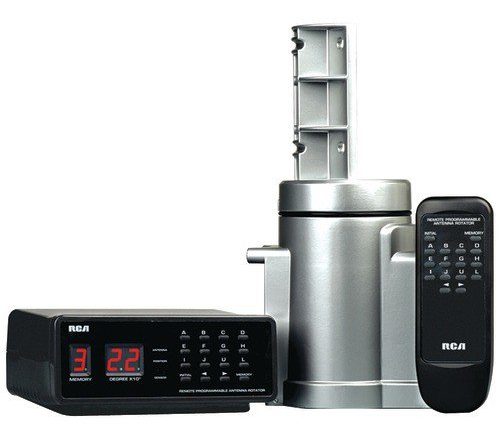When you put up an antenna rotator, you can pull in stations from different directions by simply rotating the antenna. Adding a rotator is a good upgrade, but you will need to add a second wire in addition to the regular RG6 cable. Why? Because it’s a control freak.
Antenna rotators are a pretty hot item at Solid Signal. One of my favorites is this RCA rotator. A rotator lets you precisely aim your antenna as needed so that you can get distant stations that are in different cities. It’s a must-have accessory if you live near one city but like the sports teams of a neighboring city. Imagine for example living near Milwaukee but being a Bears fan. Using a rotator would let you aim the antenna toward Chicago when needed but still get the Milwaukee local news whenever you want.
While installing a rotator is easy, it does require that you install a second cable that’s just used to control it. The rotator doesn’t come with it, but you can get the perfect cable here. This may mean drilling an extra hole in the wall, and while that’s a short-term annoyance, it’s not the worst thing in the world to do if you do it right.
Some folks have asked why all the control functions of the rotator can’t be added to the regular antenna cable. Here are the top reasons:
Voltage
The rotator needs power and you need to send that power up the cable. While you could do this over a cable with a solid copper core, not every cable has a solid copper core. Also, you may be using that antenna cable to power a pre-amp and splitting off the proper current to each device could be tricky.
Control
There are three wires in a typical rotator cable. One is used for controlling the rotator. If you think about it, a rotator that you couldn’t control wouldn’t be super helpful. If you were to put this control signal onto a conventional antenna cable, it could interfere with antenna frequencies. Yes it would be possible to make sure that didn’t happen by modulating it at a very low frequency, but then you’d run into…
You don’t want to split the signal.
If the control signal were located on the same cable as an antenna and potentially a pre-amp, you would need to split that signal in such a way that the control (which travels up the wire) and the antenna signal (which travels down the wire) could go where they needed to go. This isn’t a terribly difficult thing to do from a technical perspective but splitting and combining a signal always means introducing noise and losing signal. Some of the signal is just lost due to the mechanical nature of the splitter and that’s unavoidable.
In some cases up to 90% of a signal can be lost in a splitter. Obviously what you’re trying to do in the case of a rotator is lose as little signal as possible. You also want to keep noise as low as possible. You can amplify the signal to compensate for the loss but you can’t ever get rid of the noise. That means that truly weak signals could be lost in the process.
So, really, that second cable is the way to go. It’s a little less convenient but a lot better for getting you the strong, distant signals you want.





